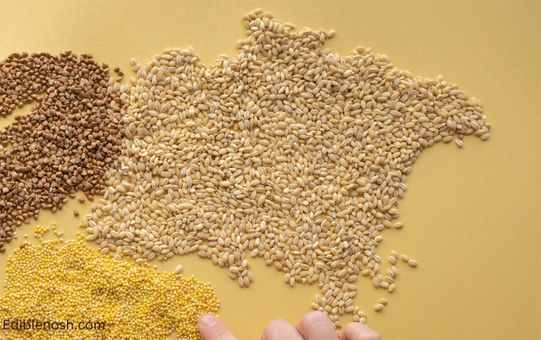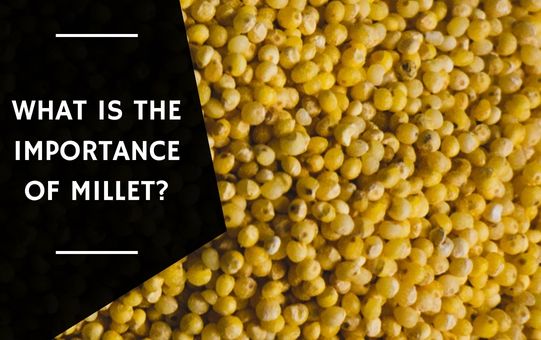Millet is a small, round grain that is frequently overlooked, but it packs a nutritional and sustainability punch. However, what is the importance of millet?
Millet grains are enriched in minerals and vitamins, such as iron, vitamin B, Phosphorous, and magnesium. It can be grown with minimal irrigation and requires fewer pesticides and fertilizers than other grains. Millet is considered a versatile grain that can easily be incorporated into various dishes, to make them delicious and nutritious for all age group individual.
This article will discuss the numerous health benefits of millet and why it should be incorporated into your diet.
Contents
Why importance of millet matter?
Millet is an important grain for many reasons. Firstly, it is a nutritious food source that is high in essential vitamins and minerals, including B vitamins, iron, magnesium, and phosphorous. It is also a good source of fiber, which is important for digestion and can help lower cholesterol levels.
Millet is low in fat and has a low glycemic index, which means that it is absorbed slowly by the body and can help regulate blood sugar levels. These nutritional benefits make millet a healthy choice for people of all ages.
In addition to its nutritional value, millet is also good for the environment. It is a drought-tolerant crop that can be grown with minimal irrigation, making it a sustainable choice for farmers in dry, arid regions. Millet is also a low-input crop, meaning that it requires fewer pesticides and fertilizers than other grains.
This is important for protecting the environment and reducing the impact of agriculture on natural resources. Millet is also a good rotational crop, which means that it can be grown in rotation with other crops to improve soil health. This is especially important in areas where the soil has been damaged by overuse or erosion.
Read Also: Why Should We Soak Millet Before Cooking?
What is Millet?
Millet is a type of cereal grain that belongs to the grass family. There are several different types of millet, including pearl millet, finger millet, proso millet, and foxtail millet.
These grains are native to many parts of the world, including Asia, Africa, and Europe. Millet is a staple food in many countries, especially in dry, arid regions where other crops may not thrive.
Millet is a small, round grain that is similar in size to couscous or quinoa. It has a mild, nutty flavor and can be cooked in a variety of ways.
It can be ground into flour, used as a hot breakfast cereal, or added to soups and stews. Millet is also often used in birdseed and animal feed.
The Nutritional Value of Millet
Millet is a nutritious grain that is packed with essential vitamins and minerals. It is a good source of B vitamins, including niacin, thiamin, and B6. Millet is also high in minerals such as iron, magnesium, and phosphorous.
These nutrients are important for maintaining good health and supporting various bodily functions.
Millet is also a good source of fiber. One cup of cooked millet contains about 6 grams of fiber, which is important for digestion and can help lower cholesterol levels.
Millet is also low in fat and has a low glycemic index, which means that it is absorbed slowly by the body and can help regulate blood sugar levels.

The Environmental Benefits of Millet
In addition to its nutritional value, millet is also good for environmental benefits. Millet is a drought-tolerant crop that can be grown with minimal irrigation.
This makes it a sustainable choice for farmers in dry, arid regions. Millet is also a low-input crop, meaning that it requires fewer pesticides and fertilizers than other grains.
Millet is also a good rotational crop, which means that it can be grown in rotation with other crops to improve soil health.
Millet helps to add organic matter to the soil, which can improve soil structure and fertility. This is especially important in areas where the soil has been damaged by overuse or erosion.
How to Incorporate Millet into Your Diet?
Millet is a versatile grain that can be incorporated into a variety of dishes. Here are a few ideas for how to add millet to your diet:
- Hot breakfast cereal: Cook millet in water or milk and serve with honey, nuts, and fruit for a tasty and nutritious breakfast.
- Soups and stews: Add cooked millet to soups and stews for a heartier, more satisfying meal.
- Salad: Toss cooked millet with vegetables, nuts, and a vinaigrette for a flavorful and filling salad.
- Baked goods: Millet flour can be used to make bread, muffins, and other baked goods.
- Pilaf: Cook millet in broth with vegetables and herbs for a flavorful pilaf.
Read Also: Why Should We Eat Millets?
Conclusion
Millet is a nutritious and sustainable grain that is worth incorporating into your diet. It is packed with essential vitamins and minerals, has a low glycemic index, and is good for the environment.
Whether you are using it as a hot breakfast cereal, adding it to soups and stews, or using it in baked goods, millet is a tasty and versatile grain that can be enjoyed in a variety of dishes.
So the next time you are looking for a new grain to try, consider giving millet a chance. You might just be surprised by all the health benefits it has to offer.
FAQs | Importance of Millet
Here are a few FAQs related to the importance of millet:
What Is Millet?
Millet is a small, round grain that belongs to the grass family. There are several different types of millet, including pearl millet, finger millet, proso millet, and foxtail millet.
Millet is native to many parts of the world, including Asia, Africa, and Europe, and is often used as a staple food in dry, arid regions.
What Are The Nutritional Benefits Of Millet?
Millet is a nutritious grain that is high in essential vitamins and minerals, including B vitamins, iron, magnesium, and phosphorous. It is also a good source of fiber, with one cup of cooked millet containing about 6 grams of fiber.
Millet is low in fat and has a low glycemic index, which means that it is absorbed slowly by the body and can help regulate blood sugar levels.
How Can I Incorporate Millet Into My Diet?
Millet is a versatile grain that can be used in a variety of dishes. It can be cooked as a hot breakfast cereal, added to soups and stews, used to make a salad, or used in baked goods like bread and muffins. Millet flour can also be used to make gluten-free baked goods.
Is Millet Good For The Environment?
Yes, millet is good for the environment. It is a drought-tolerant crop that can be grown with minimal irrigation, making it a sustainable choice for farmers in dry, arid regions.
Millet is also a low-input crop, meaning that it requires fewer pesticides and fertilizers than other grains. Additionally, millet is a good rotational crop, which means that it can be grown in rotation with other crops to improve soil health.
Is Millet Gluten-Free?
Yes, millet is naturally gluten-free. This makes it a good option for people with gluten intolerance or celiac disease.
However, it is important to note that millet may be processed in facilities that also process wheat, so it is always best to check the label to ensure that the millet you are purchasing is gluten-free.

